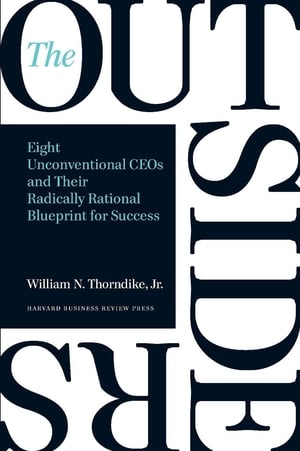Capital allocation can be defined as the process of deciding how to deploy a firm's resources to earn the best possible return for shareholders. Understanding and evaluating a company's capital allocation decisions, process and history is therefore critical to analysing potential investments.
One of my favourite books on capital allocation is The Outsiders. This book was written by William Thorndike who reflected that "Surprisingly, in business the best are not studied as closely as in other fields like medicine, the law, politics or sports," and "Despite its importance, there are no courses on capital allocation at the top business schools."
The book focusses on eight unconventional CEOs whose company's share prices massively outperformed the market. The list of CEO's include Henry Singleton from Teledyne, John Malone from Liberty Media, Katherine Graham from the Washington Post, Tom Murphy from Capital Cities Broadcasting and of course Warren Buffett of Berkshire Hathaway. In fact the book was the number one book on Mr Buffett's recommended reading list in 2012. Mr Thorndike noted these CEOs "thought more like investors than managers." It's no surprise many of the characteristics that define great company managers are common to the Investment Masters.
"Effective capital allocation .. requires a certain temperament. To be successful you have to think like an investor, dispassionately and probabilistically, with a certain coolness." Michael Maboussin
While each of the Outsider CEOs operated in different industries - some growing while others declining, with different capital intensities - there were many commonalities in how they managed their businesses. While it wasn't rocket science, the management style and initiatives these eight CEOs implemented, was unconventional for the time.
Some of the common characteristics included:
Acquisitions - while most of the CEOs were involved in acquisitions they were both opportunistic and patient. Acquisitions were only made when there was compelling discrepancies between value and price or when significant cost savings could be extracted. These CEOs either refrained from or were reluctant to issue scrip for acquisitions and only if the scrip was expensive and the 'Business Value' [ie intrinsic value] acquired was greater than the 'business value' given.
This latter point, in my view, is one of the most common mistakes CEOs and company boards make. They acquire expensive assets funded via either scrip mergers or capital raisings when their own share prices do not reflect their company's worth. While acquired assets may be high quality and accretive to earnings, these acquisitions can be hugely value destroying.
In his 1982 annual Berkshire letter, Warren Buffett provided an excellent overview of this common situation.
"Our share issuances follow a simple basic rule; we will not issue shares unless we receive as much intrinsic business value as we give. Such a policy might seem axiomatic. Why, you might ask, would anyone issue dollar bills in exchange for fifty-cent pieces? Unfortunately, many corporate managers have been willing to do just that."
"[In relation to] the acquirer who ends up using an undervalued (market value) currency to pay for a fully valued (negotiated value) property. In effect, the acquirer must give up $2 of value to receive $1 of value. Under such circumstances, a marvellous business purchased at a fair sales price becomes a terrible buy. For gold valued as gold cannot be purchased intelligently through the utilisation of gold - or even silver - valued as lead." Warren Buffett
Divestments - the Outsider CEOs were not in the business of growing for growth's sake. If another party wanted to pay an inflated price for an asset and the CEO no longer saw the growth potential of that asset they would not be afraid to shrink the business, sometimes substantially. If the market was undervaluing a part of the business the CEO would look to spin-off the division to realise that value. Should a business be underperforming with little prospect for a turnaround it was likely slated for sale or closed. The Outsider CEOs were not emotionally attached to any division and they cut their losing businesses. Capital investment was reserved only for those businesses with attractive returns on capital. The core focus was maximising long term value per share, not organisational size or growth.
Buy-backs - the CEOs were opportunistic acquirers of their own shares, BUT only when they deemed them to be trading below 'Business Value'. In many cases shares were repurchased in bear markets or when P/E's were at cyclical lows. Sometimes these buybacks were substantial. For example, in the case of Teledyne, over 90% of the shares on issue. All potential acquisitions were compared with the returns available from buybacks. Once again CEOs were not afraid to shrink their businesses.
Cash Flow - the CEOs focussed on cash flow per share not reported net income. The Outsider CEOs believed the "key to long-term value creation was to optimise free cash flow, and this emphasis on cash informed all aspects of how they ran their companies - from the way they paid for acquisitions and managed their balance sheets to their accounting policies and compensation systems."
Humility - the Outsider CEOs were humble, understated and analytical. The Outsider CEOs were distinctly "unpromotional". Mr Thorndike noted they "had familiarity with other companies and industries and disciplines, and this ranginess translated into new perspectives, which in turn helped them to develop new approaches that eventually translated into exceptional results."
Guidance/Dividends - none of the Outsider CEOs gave Wall Street guidance. Their focus was increasing the long term value per share. Taking a longer term view meant, at times, making investments or capital expenditures that may have detracted from short term earnings but added to long term value. The Outsider CEOs were frugal with regards dividends, realising the compounding benefits of reinvesting capital either in the business or in their own shares should their prices be depressed.
Decentralisation - the CEOs ran decentralised organisations where significant autonomy was given to operating managers. This allowed managers at the coal face to respond quickly to a changing marketplace and for the CEOs to focus on capital allocation and strategic planning.
Flexibility - the CEOs recognised the need to remain flexible as business conditions and markets were uncertain and constantly changing. At certain times it made sense to make acquisitions while other times favoured selling or spinning off assets. The Outsider CEOs did not have an ideology and were not bound by a strategy.
Mr Thorndike noted that, "although the outsider CEOs were an extraordinarily talented group, their advantage relative to their peers was one of temperament, not intellect." Great CEOs possess patience, independence, humility and a contrarian streak for success. It's the CEOs that get caught up in the emotional tides of the market, overpay for acquisitions, issue scrip at the wrong prices, focus on the short term and refuse to adapt to change that will destroy companies and your portfolio's returns.
Further Reading -
'Capital Allocation - Evidence, Analytical Methods, and Assessment Guidance' by Michael Maboussin (Credit Suisse)
'Phil Fisher on Mergers & Acquisitions' (Investment Masters Class)
'The Essays of Warren Buffett' - 'Mergers & Acquisitions'



